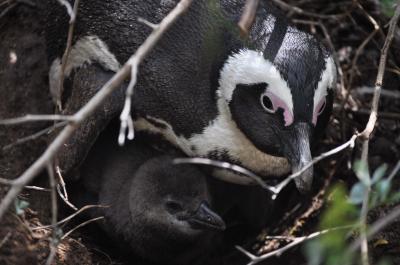
Penguin fossils from 10 million to 12 million years ago have been unearthed in South Africa, the oldest fossil evidence of these cuddly, tuxedoed birds in Africa.
The new discovery, detailed in the March 26 issue of the Zoological Journal of the Linnean Society, could shed light on why the number of penguin species plummeted on Africa's coastline from four species 5 million years ago to just one today — Spheniscus demersus, or the jackass penguin, known for their donkeylike calls.
Daniel Thomas, a researcher at the National Museum of Natural History, and colleague Daniel Ksepka of the National Evolutionary Synthesis Center were studying rock sediments near a steel plant in Cape Town, South Africa, when they uncovered an assortment of fossils, including 17 pieces that turned out to be backbones, breastbones, legs and wings from ancient penguins.
The bones suggested these ancient birds ranged from 1-to-3 feet tall (0.3 to 0.9 meters). For comparison, Africa's living jackass penguin, also called the black-footed penguin, stands at about 2-feet tall (0.6 meters) and weighs between 5.5 and 8.8 pounds (2.5 and 4 kilograms). [Happy Feet: A Gallery of Pudgy Penguins]
The discovery pushes back the penguin fossil record in Africa by at least 5 million years.
Because the next oldest fossils from Africa date to 5 million years ago, it's tricky to determine exactly why most penguin species disappeared from Africa.
"It's like seeing two frames of a movie," Ksepka said in a statement. "We have a frame at five million years ago, and a frame at 10-12 million years ago, but there's missing footage in between."
Get the world’s most fascinating discoveries delivered straight to your inbox.
One possibility is that changing sea levels eliminated most of the penguins' nesting sites.
About 5 million years ago, sea levels were 296 feet (90 m) higher than today, and the low-lying South Africa became a patchwork of islands. Those islands provided beaches for several penguin species to create nests and rear their young while sheltering them from predators.
Once the oceans fell, most of those beaches would become mainland.
Africa's remaining jackass penguins are also on the decline. Their numbers have plummeted by 80 percent, in part because humans are overfishing their staple foods, sardines and anchovies. African penguins are being bred in captivity; for instance, a successful breeding season at the New England Aquarium in 2010 ended with the birth of 11 new African penguin chicks.
In addition, Bristol Conservation and Science Foundation, along with South African and international partners, is working to establish breeding colonies of the African penguin closer to fish resources, to ensure successful chick-rearing, according to the World Association of Zoos and Aquariums.
Follow Tia Ghose on Twitter @tiaghose. Follow LiveScience @livescience, Facebook & Google+. Original article on LiveScience.com.

Tia is the editor-in-chief (premium) and was formerly managing editor and senior writer for Live Science. Her work has appeared in Scientific American, Wired.com, Science News and other outlets. She holds a master's degree in bioengineering from the University of Washington, a graduate certificate in science writing from UC Santa Cruz and a bachelor's degree in mechanical engineering from the University of Texas at Austin. Tia was part of a team at the Milwaukee Journal Sentinel that published the Empty Cradles series on preterm births, which won multiple awards, including the 2012 Casey Medal for Meritorious Journalism.
 Live Science Plus
Live Science Plus





